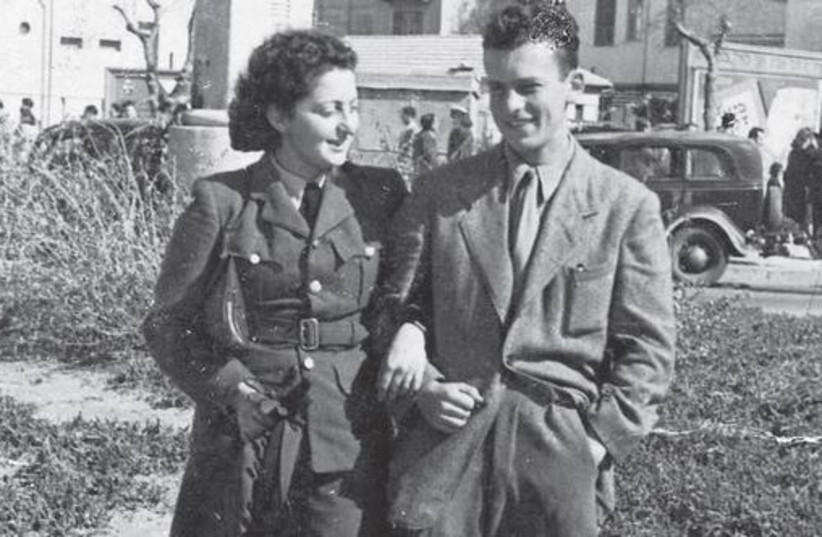“There are stars whose radiance is visible on Earth though they have long been extinct. There are people whose brilliance continues to light the world even though they are no longer among the living. These lights are particularly bright when the night is dark. They light the way for humankind.” – Hannah Senesh

In June 1984, I received an article from the Amerikai Magyar Szó (American Hungarian Word) newspaper which covered the memorial of my mother’s sister, Hungarian partisan Ilona Klein, who was born in 1924.
Unfortunately, my mother had just passed away in May. She would have been glad to see that her sister was being honored and recognized by the Hungarian government for her heroic sacrifice with a memorial plaque in Budapest. The memorial was presented by Ilona’s fellow partisans.
Early in 1988, I made a trip to Hungary to learn more about what happened to my mother’s family during the Holocaust and in particular to discover more information about my mother’s sister, Ilona.
My mother was one of seven children, six of whom were girls. Ilona was the youngest. During the Holocaust, my grandparents lived in the city of Kisvarda.
They were moved into the nearby ghetto together with their son, who was injured in a forced labor camp, along with other Jews of the city, starting on April 8, 1944.
On Shavout, May 28, 1944, they were deported to the gas chambers of Auschwitz. My mother’s older sister, Esther, as well as her husband, Resu, and their two children, Zoltan and Robbie, were also deported to Auschwitz and were murdered there.
My mother and her four other sisters had gone to live in Budapest in 1940. In 1944, my mother was forced to live in what was called a Yellow-Star House.
However, with the help of one of her sisters, she managed to obtain Christian identification documents and was able to live as a Christian through the rest of the war. Three of her other sisters lived as Christians as well.
When I visited Budapest in 1988, I learned about Ilona’s story from a meeting I had with some of her fellow partisans. Ilona was working in a factory and was part of a labor trade union group. They took part in some demonstrations in front of the statue of Hungarian poet Sandor Petofi in 1942.
In 1943, 11 members of the trade group including Ilona formed an armed resistance group against the Nazi fascists. Most of the group were not Jewish. In 1944 the group traveled to Yugoslavia to join Marshal Tito’s partisan battalion.
They trained in the Serbian Fruska Gora mountain partisan camp and were assigned to scout the mountains of Bosnia where armed actions took place.
According to Ilona’s fellow partisans, on April 17 1944, near the village of Sremeska Racsa, Ilona was wounded, and later captured, tortured and killed by Nazi forces. She was 20 years old.
In 1986 eight of Ilona’s fellow partisans went to Semreska Racsa, to visit the exact spot where Ilona was shot.
Ilona’s last name was Klein which means small in German. The partisan’s called her by a Hungarian nickname “Nagy” which in Hungarian means big, because she was tall. On her plaque in Budapest her name reads “Ilona Nagy Klein.”
I visited the monument in Budapest. Besides this monument, there was also a memorial plaque on the home where she was born, in the town of Olaszliszka.
In 1984, the president of the Socialist Republic of Yugoslavia, Veselin Duranovic, also awarded Ilona a posthumous memorial charter in recognition of her participation in the struggle against fascism.
Ilona and the story of her fellow partisans are mentioned in the book by Ference Mora titled, “Hungarians in the anti-Fascist Movement in Europe.”
As part of the memorial for Ilona her fellow partisans wrote: “Our honorable friend was lost. She fought for liberation and freedom. She did not want to be a hero, but she was aware of the risks and dangers.”
My mother told me about the time when by chance she met Ilona’s fellow partisans on a street in Budapest not long after the war had ended. My mother said that she asked about Ilona, asked about where Ilona was and what had happened to her.
According to my mother the partisans were very hesitant to disclose what happened to Ilona but eventually broke down and cried and told her.
And why do I want to tell this story now? Maybe it is because I think that it is important to highlight the Jewish Resistance to the Nazis in whatever form it took.
As Elie Wiesel wrote: “To forget nothing, to efface nothing, that is the obsession of survivors; to plead for the dead, to defend their memory and honor.”
Perhaps this applies to children of survivors as well.■
The writer is a Jewish educator and social worker who lives in New York. His father was a survivor of the Buchenwald concentration camp.
